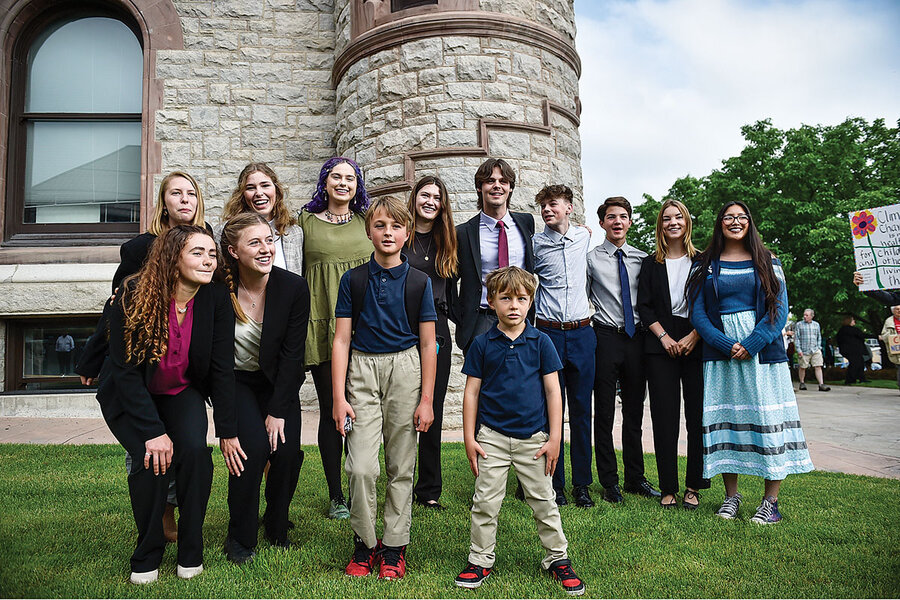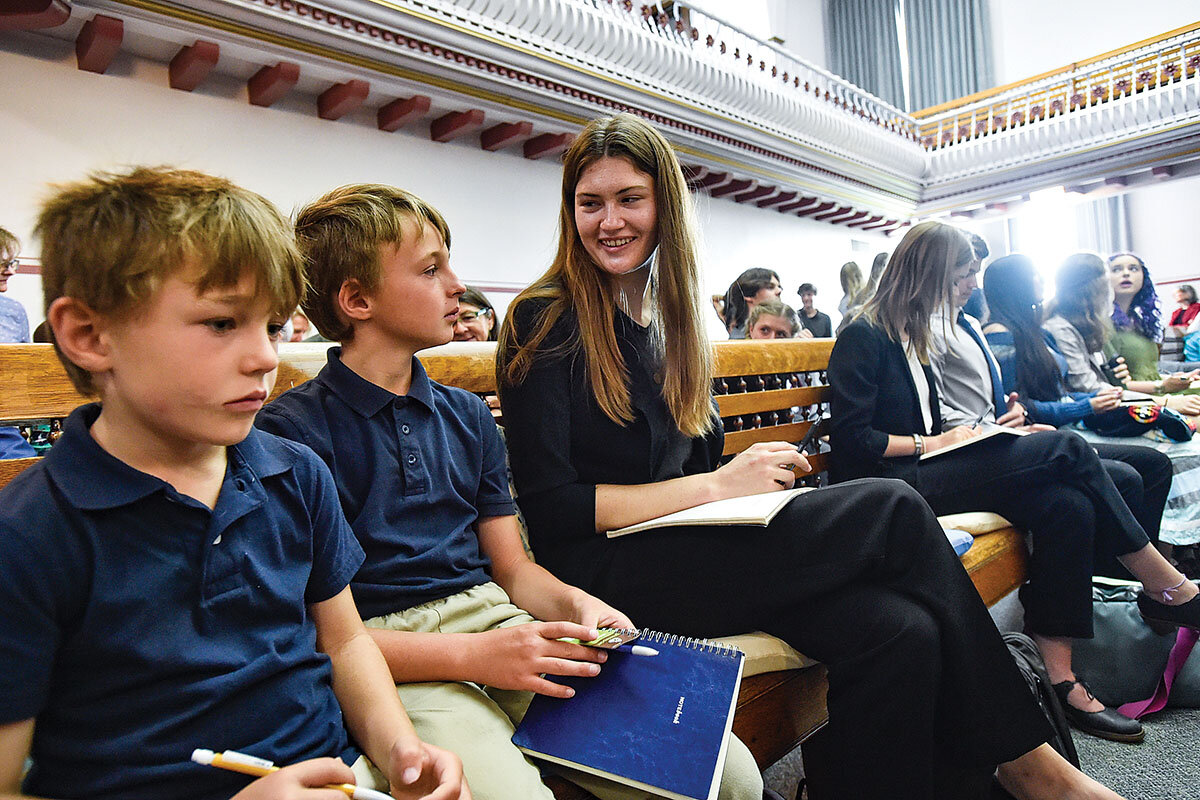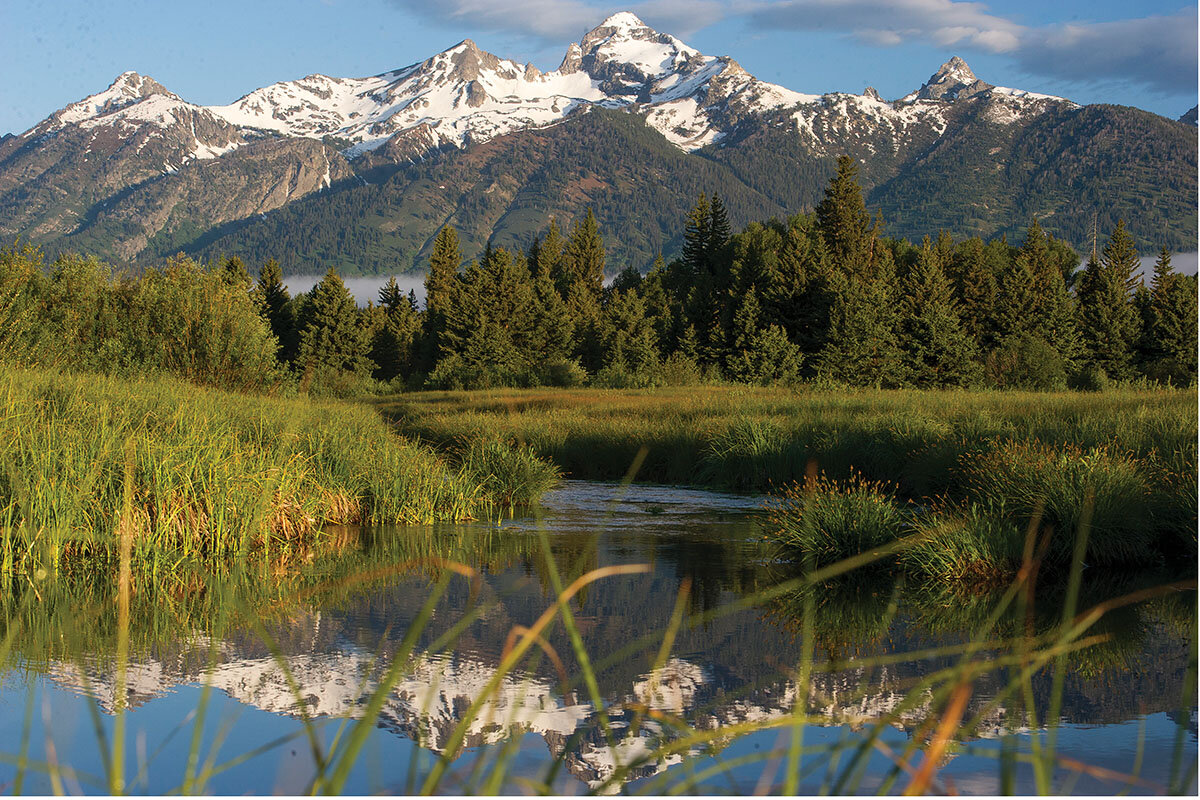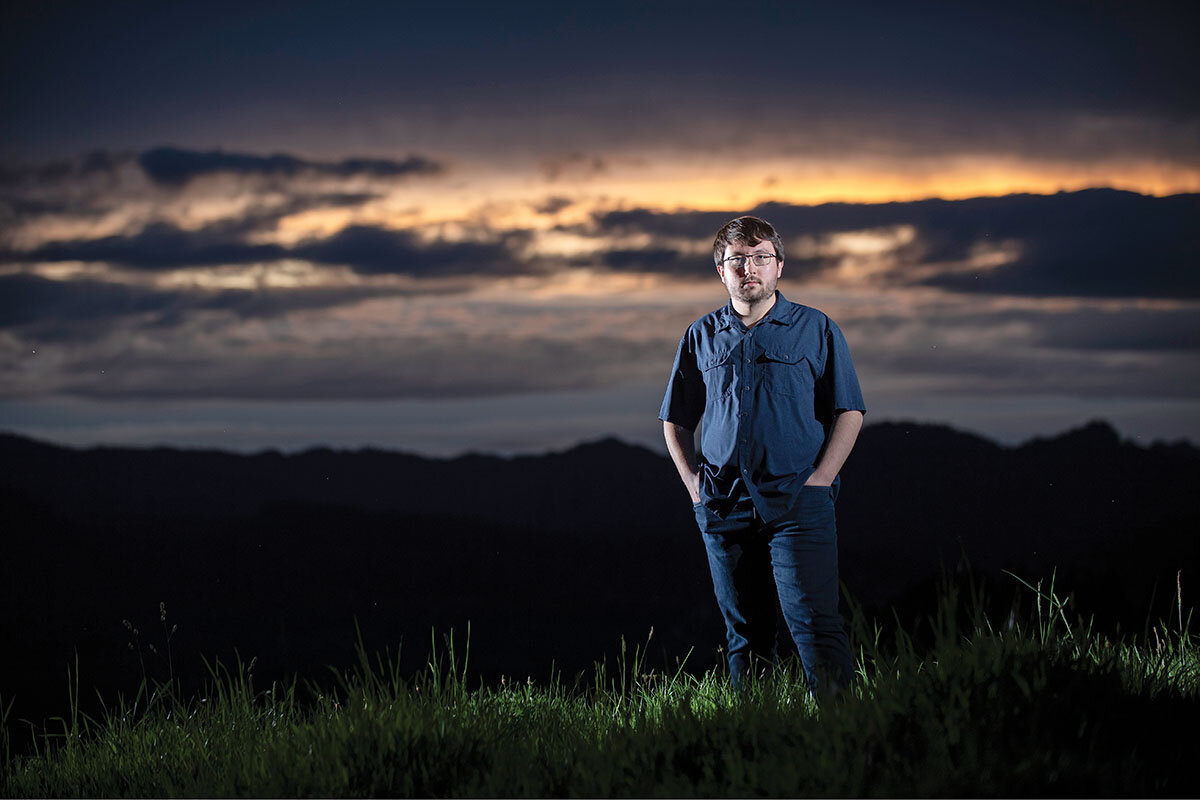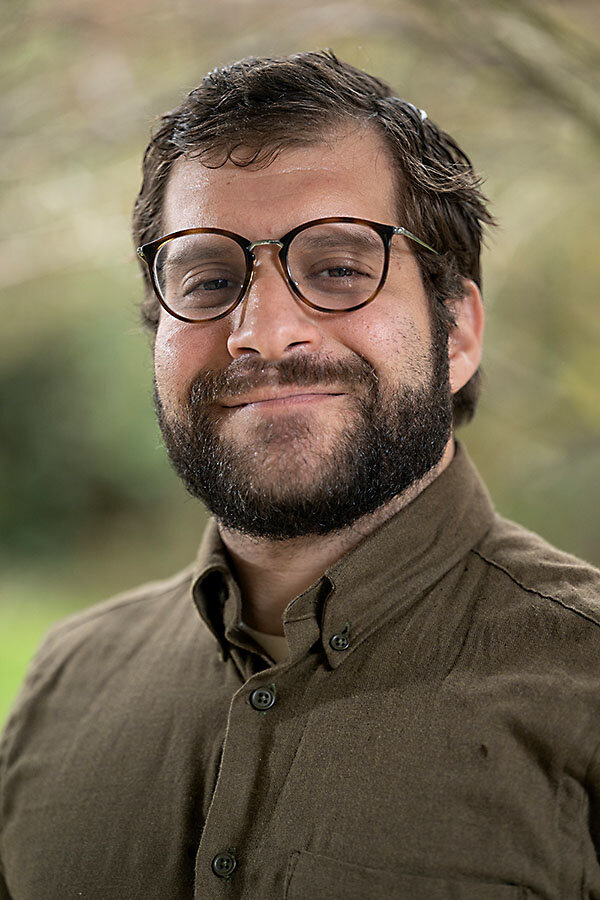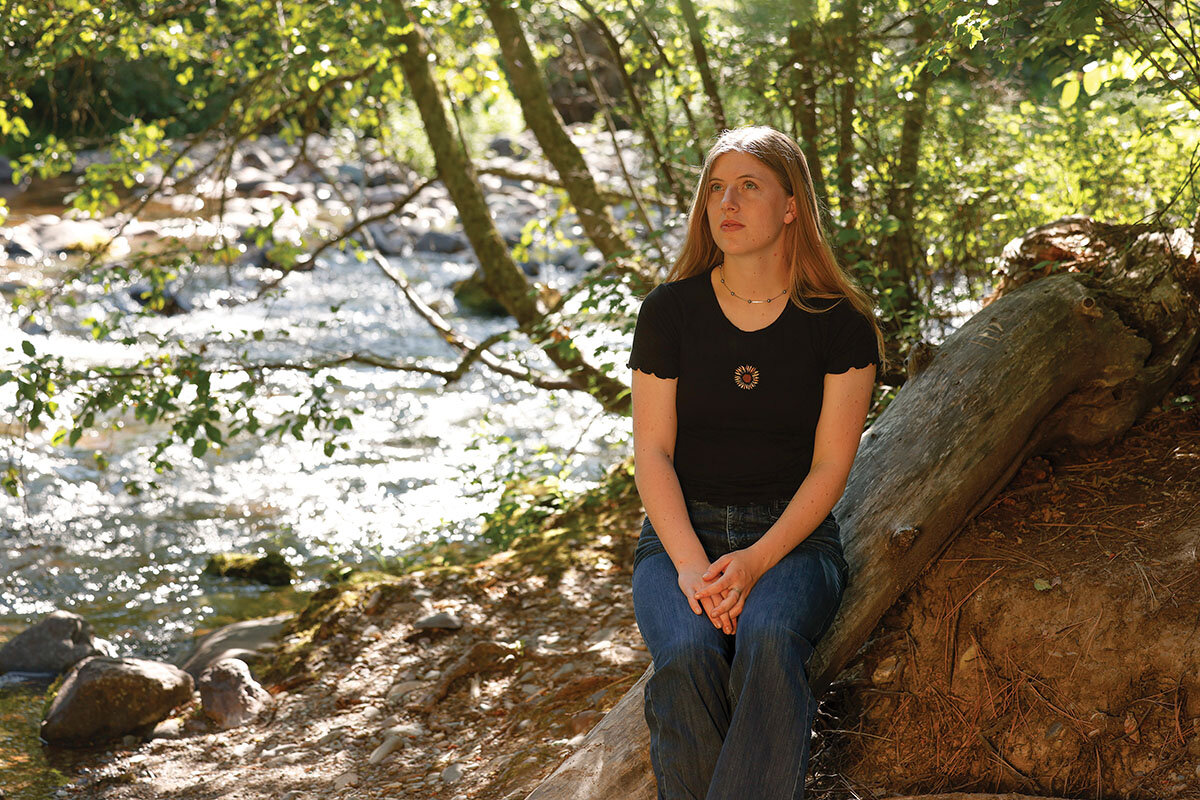Suing the world to save it. Children pioneer a right to a secure future.
Loading...
| Missoula, Mont.
In June 2023, the hottest June ever recorded in a summer that would break global heat records, 16 young people walked into a courthouse in Helena, Montana, and insisted they had the right to a stable climate.
They asked the government of Montana to uphold its Constitution, one of a handful in the United States that explicitly protects current and future citizens’ right to a healthful environment.
Why We Wrote This
A story focused onEco-anxious young people are forging a body of law protecting against the effects of climate change. Part 4 in a seven-part series.
The state argued that the well-intentioned children were being exploited by an outside interest group.
For years, youth around the world have been suing governments to address what scientists worldwide agree is an environmental crisis caused by human behavior. But in the U.S., the country responsible for sending more heat-trapping gases into the atmosphere than any other nation, young people had failed to get courts to rule in their favor.
Then the Montana judge ruled in the plaintiffs’ favor last summer, saying Montana policymakers had violated the young people’s constitutional rights by ignoring the climate impacts of their energy decisions.
For what we call the Climate Generation, young people born since 1989, the case was “incredibly important,” says Shaina Sadai, the Hitz fellow for litigation-relevant science at the Union of Concerned Scientists. “A win anywhere for any of them is a win for all of them.”
In June 2023, the hottest June ever recorded in a summer that would break global heat records, 16 young people walked into a courthouse in Helena, Montana, and insisted that they had the right to a stable climate.
The moment was, in the United States, unprecedented.
For years, youth around the world had been suing governments – state, regional, federal – and demanding more action by policymakers to address what scientists worldwide agree is an environmental crisis directly caused by human behavior. By 2022 there had been 34 global climate cases brought on behalf of plaintiffs ages 25 and younger – part of a global climate litigation explosion, according to Columbia University’s Sabin Center for Climate Change Law.
Why We Wrote This
A story focused onEco-anxious young people are forging a body of law protecting against the effects of climate change. Part 4 in a seven-part series.
And in some places, young people had begun to make headway. A German court in 2021, for instance, agreed with youth that the government needed to do more to reduce emissions. Colombia’s Supreme Court agreed with young plaintiffs in 2018 that officials needed to better protect the Amazon rainforest, in part because of climate concerns.
But in the U.S., the country that has sent more heat-trapping gases into the atmosphere than any other nation, young people had failed to get courts to rule in their favor.
That was about to change.
In the courtroom that day, the young people were asking not for any financial reward, but for the government of Montana to uphold its Constitution, one of a handful in the U.S. that explicitly protects both current and future citizens’ right to a healthful environment. There was Rikki Held, the oldest of the Montana youth plaintiffs at 22, whose name was on the lawsuit and whose family’s ranch was increasingly threatened by fires and floods. There were Lander and Badge Busse, teenage brothers whose schoolmates taunted them about this case, but who’d decided they needed to be part of this lawsuit to protect the wilderness where they loved to fish and hunt. And there was Grace Gibson-Snyder, a Missoula 19-year-old. Her ancestors had come to this big-sky state in a covered wagon. But Ms. Gibson-Snyder worried about whether this land would be habitable for her own children – if she felt it were morally appropriate to have any. She wore her favorite boots to trial, for good luck.
They and their fellow plaintiffs were represented by an Oregon-based law firm called Our Children’s Trust, which has helped young people across the country bring constitutional climate cases.
Opposing them was the state of Montana, represented by an attorney general whose spokesperson had called the lawsuit “outrageous” and “political theater” – a case of well-intentioned children exploited by an outside interest group.
For the better part of the next two weeks, the two sides presented their cases.
Then youth and legal experts waited anxiously for the judge’s decision. Held v. Montana, many said, was a crucial moment in what they saw as a legal transformation building around the world. Members of the Climate Generation – as we’re calling the cohort born since 1989, when the world became both climatically unstable and increasingly focused on children’s rights – were working to define what it meant to have rights as a young person. And in particular, they were working to define what it meant to have rights while looking at a future that scientists agree will be shaped by what older people have done to the atmosphere. A ruling in Montana could dramatically impact this global effort.
“The Montana case is incredibly important,” says Shaina Sadai, the Hitz fellow for litigation-relevant science at the Union of Concerned Scientists. Young people involved with climate action, she adds, “are very internationally connected. They are very much in touch with each other. ... A win anywhere for any of them is a win for all of them. It’s that global youth solidarity.”
Which is why Dallin Rima, a 19-year-old plaintiff in a different climate lawsuit, turned up the radio when he heard that Montana District Judge Kathy Seeley had released her verdict.
Mr. Rima is part of a group of Utah youth who have sued their state, arguing that its promotion of fossil fuels violates their constitutional rights to life, health, and safety. He’d been following what was going on in Montana, the same way young climate plaintiffs from Oregon to the South Pacific to Portugal had been keeping track. While he knew firsthand about the challenges of the legal system, about the delays and disappointments, he had allowed himself to hope.
He was driving to his grandmother’s house outside Salt Lake City, listening to NPR, when the news came on. It was a good thing nobody else was in the car, Mr. Rima says. Because as he listened to the newscast, he began to “express himself,” as he puts it. Loudly.
The judge had ruled in the young plaintiffs’ favor. Specifically, this meant that Montana policymakers had violated the young people’s constitutional rights by ignoring the climate impacts of their energy decisions. But Mr. Rima understood that there were far broader implications.
By siding with the young Montanans, Judge Seeley explicitly connected the right to a clean environment with the right to a stable climate. She gave a judicial stamp of approval to climate science. And she proved that, in the face of what many young people see as politicians’ ineptitude in addressing climate change, the judiciary is a branch of government that might still be able to protect their futures.
“I’ve learned not to get my hopes up. But I was just shocked, ecstatic to hear that they had won,” Mr. Rima says. “It was a really powerful moment. ... It feels like our work isn’t in vain.”
Children’s rights and climate science
By the time the young people in Montana first filed their complaint against the state in 2020, the number of climate cases worldwide was already starting to increase dramatically. This was in part an offshoot of the growing youth activism around global warming during the late 2010s, with groups such as Greta Thunberg’s Fridays for Future beginning to stage school climate strikes and other protests around the world.
But the increase in these cases was also a reflection of two big developments: the evolution of children’s rights and of the science of climate change.
In 1989 – the beginning of the Climate Generation – world leaders agreed to the United Nations Convention on the Rights of the Child (UNCRC), an effort that both defined “children” as those under the age of 18 and called on nations to protect children’s access to things like safety, education, and freedom of movement. (Every country in the world except the U.S. has ratified this convention.)
Meanwhile, during those same years, there was a growing understanding of – and attention to – the problem of climate change.
In many ways, the youth effort to bring climate concerns into the judicial system was a merging of these two understandings – that they had rights, and that climate change was threatening those rights.
At the heart of this argument was a cruel scientific fact: The situation was only going to get worse, and young people were going to disproportionately face the consequences.
Global warming is cumulative. In other words, heat-trapping gases don’t just go away; they hang out in the atmosphere for centuries. So today’s emissions are joining those of the 1900s, trapping even more solar heat inside the Earth’s atmosphere. This means that some amount of global heating is inevitable, scientists say. Regardless of how the world adjusts today, those people born at the turn of the century will live in a world fundamentally environmentally different from what those born in 1960, or even 1980, experienced.
But how different is still very much a question. Scientists have modeled different scenarios of warming, based on whether or not the world quickly ramps down greenhouse gas emissions. And the difference in what it will mean to live on Earth is profound.
This is not only because the average temperature will get higher the more greenhouse gases go into the air. For such a life-giving planet, Earth’s environmental systems, which include everything from ocean currents and storms to heat waves and ice flows, are delicately balanced. With every added fraction of a degree comes the potential for a cascade of climatic impacts, from the sort of heat waves that cooked the Northern Hemisphere this summer to the supercharged storms that have battered everywhere from Florida to Mexico to Mozambique. A rapid decrease in greenhouse gas emissions today would make a tremendous difference in the severity and frequency of climate catastrophes in the future – and, by extension, the quality of life for young people as they reach adulthood.
And yet, the world has not lowered its greenhouse gas emissions. It has done the opposite.
“Half of all emissions have happened since 1990,” says Dr. Sadai of the Union of Concerned Scientists. “It’s not only getting worse, but it’s getting worse at a faster and faster rate.”
This is not, young people know, because policymakers have been unaware of the consequences. For the past 20 years, politicians around the world have been making – and then breaking – promises about addressing what they have all agreed is a dire global situation.
In 1992, the United Nations created what was called the U.N. Framework Convention on Climate Change. It was basically a statement that recognized both the reality as well as the danger of climate change, and a commitment to stabilize greenhouse gas concentrations, with developed countries leading the way. Over the next years there were more gatherings and pledges, such as the Kyoto Protocol in 1995, which legally bound developed countries to reduce their emissions, and the Paris Agreement in 2015, when countries again pledged to really get serious about the problem.
To Alex Loznak, who was growing up during those years on a southern Oregon farm that’s been in his family for generations, all of this was a sign that when it came to his future, he could not trust policymakers.
The legal victory “lights a path forward”
Mr. Loznak, now 26, had become interested in environmental issues and climate change early, first as a home-taught elementary schooler, and then as an older child who noticed what the rising temperatures and unpredictable weather were doing to his family’s hazelnut and plum trees. By the time he went to high school in Roseburg, Oregon, he was leading environmental and climate awareness clubs, and was monitoring what elected officials and diplomats were saying and doing – or not doing – about climate change.
“I remember watching a few really big policy failures to put together a coherent response to climate change,” he says. “One of those was [the U.N.] Copenhagen climate change summit, which people had expected to be this huge global turning point. There was going to be a treaty to deal with climate change, and every nation was going to step up to the plate. And that for the most part fell apart. This was in 2009.”
He also remembers watching as Congress tried – and failed – to pass a federal law to deal with climate change.
“It started to get me thinking about what would be some other pathways to deal with this climate change problem,” he says.
A few years later, he came across the writings of a legal scholar named Mary Christina Wood. She had written a book called “Nature’s Trust,” which argued that traditional environmental law – typically focused on regulations and piecemeal enforcement – failed to live up to modern-day ecological problems. She proposed using the public trust doctrine, a legal principle establishing that certain natural and cultural resources belong to the public under government stewardship, as a way to tackle big environmental issues like climate change.
It was a novel approach, and one that had a lot of legal pushback. But Mr. Loznak was fascinated. Not long after learning about Dr. Wood’s work, he heard about Our Children’s Trust, which was looking for plaintiffs in Oregon to join a climate change case against the federal government – and was using theories similar to the ones he had read about.
Maybe, he thought, a court case would be the way to get real action on climate change.
He wrote to the lawyers and eventually became a plaintiff in Juliana v. U.S., the first youth climate case to move forward against the U.S. government. Mr. Loznak and other plaintiffs filed their first complaint in 2015.
They are still involved in legal proceedings and have mostly faced setbacks. Climate, the courts kept saying, was not a judicial matter.
So Mr. Loznak, too, was interested in what would happen in Montana. He followed the news reports and press releases about the trial. When he heard about the judgment, he felt “gratified,” he says, but as much for what he saw as judicial functionality as for the win itself.
“It was pretty clear that the plaintiffs put on a much stronger case than the government did,” he says. “I see [the judgment] as something that lights a path forward, on the state level and on the federal level. I hope it will put to bed this notion that cases like this are not serious, or are just publicity stunts or political statements. A lot of people have treated them that way. What we see now is that these are serious legal cases and they can result in judgments against government actors.”
Rule of law, not a debate
David Schwartz always thought it was a serious legal case. An environmental lawyer born in 1990 and “into an unstable climate,” as he puts it, he joined Our Children’s Trust as a staff attorney in 2021 and soon began working on the Montana case.
He noticed that his clients, younger members of the Climate Generation, were far more aware of the heating world than he had been as a child growing up in Southern California.
“I wasn’t going to climate marches. I wasn’t signing on to petitions to stop this or that pipeline or something. It just wasn’t on my radar,” he says. And that’s how it should be, he says. “It shouldn’t have to fall on [children]. There are adults in the room, and key decision-makers who should be charting a sustainable path for humanity.”
But as a lawyer, he also recognized that young people, with arguably the most to lose from the business-as-usual approach to climate change, might be in the best legal position to do something about it. It seemed to him to be an obvious case of inequity and equal protection rights. Science increasingly showed that one group – adults – were making decisions that clearly harmed another group: young people. For him, it was an obvious matter for the judiciary.
“Courts are the bodies that have the ability to shift the meaning of the law as social norms and scientific understanding advance,” he says. “In legislative or executive politics, bluster and compromise and not sticking with the cold hard facts can carry the day. But ... in the court of law, facts matter.”
Indeed, in the Helena courtroom, the facts of climate science came across as rock-solid: The world is getting hotter, humans are largely responsible, and the heating is causing a slew of climatic disruptions, from the wildfires that choked Grace’s soccer practices to the droughts that starved Rikki’s cattle.
For many years in the U.S., the science of global warming has been debated in the public sphere – in speeches, on social media, and so on – where critics and skeptics can present their own theories and argue with scientists. But in a trial, speculation and hearsay are against the rules. Statements are subject to cross-examination. And political or economic pressure is not supposed to sway a judge’s opinions.
In some ways, says Michael Gerrard, founder and faculty director at Columbia’s Sabin Center, which keeps a database of climate litigation, this was one of the most important aspects of Held v. Montana.
“Science deniers have long had a political platform,” he said in an interview on the eve of the trial. “But they’ve mostly tried to stay out of court because they realized they were vulnerable.”
The state ended up not calling to the stand a scientist skeptical of mainstream climate research. Instead, it focused on the argument that Montana shouldn’t be held responsible for a global problem, and that climate issues were legislative matters, not legal ones.
“What we heard in plaintiffs’ case was not justiciable controversy, but rather a weeklong hearing of political grievances that properly belongs to the Legislature, not a court of law,” said Assistant Attorney General Michael Russell during his closing statements.
Later, the attorney general’s spokesperson, Emily Flower, put out another statement.
“Montanans can’t be blamed for changing the climate,” she said. The case, she added, was a “taxpayer-funded publicity stunt.” The government has said it will appeal.
Collective responsibility
Climate change has been called a classic “tragedy of the commons” – a situation in which individuals act in their own logical self-interest and nobody is doing anything against the law. But taken together, the individual behaviors are catastrophic to the community.
Young people pushing for the courts to weigh in on climate change say that the legal system has the ability to reverse that tragedy, and make explicit a collective responsibility. A group of law students from the University of the South Pacific in Fiji, for instance, is spearheading an effort to have the International Court of Justice connect climate action to human rights. A case brought by six young Portuguese plaintiffs, which had a hearing in the European Court of Human Rights earlier this year, says 32 countries, including their own, are responsible for the extreme weather they’ve experienced in Portugal.
And in the Montana courthouse, when a state attorney asked one expert, Nobel Peace Prize-winning climate scientist Steven Running, whether young people around the world could also blame Montana for impacting their climate, the witness shrugged. Sure, he said. That’s how the atmosphere works. It doesn’t take away from the case.
“There’s a question of, how do we recalibrate our rules, our set of laws, our constitutions to the physical realities of our planet?” says David Orr, emeritus distinguished professor of environmental studies and politics at Oberlin College in Ohio. “It’s time to rethink what law is on a planet with a biosphere.”
That’s true even beyond the youth constitutional cases. In the U.S., the number of climate cases has increased dramatically, with some 2,180 underway in 2022, compared with 884 in 2017, according to the Sabin Center. Most of those cases don’t involve children’s rights; they are nonprofits suing corporations for alleged “greenwashing,” municipalities suing oil and gas companies, and individuals demanding regulation enforcement, among other matters.
Still, Robert Cox, an environmental lawyer who heads Suffolk University Law School’s Environmental Law & Policy Clinic in Boston, says that this doesn’t mean the cases don’t involve the Climate Generation. His students, and other young lawyers he sees, are particularly attuned to climate change, and are working within what he calls the “nitty-gritty” of the legal system to shape existing rules and legislation to apply to a new, heated reality.
“What I see in the younger attorneys that I practice with ... is this embedded view that climate change is an issue and we have to deal with it in one way or another,” he says. “And it dovetails with what is happening with clients, where everything they do or touch connects to climate.”
Not politics or activism, just the law
Ms. Gibson-Snyder watched the whole Montana trial from her seat in the courthouse.
She had joined the lawsuit when she was 16 and was now in the summer between her freshman and sophomore years in college. But that week in June was the first time that she had spent much time with her co-plaintiffs. While they had met each other over screens, they lived across Montana and ranged in ages. Now they were staying at the same hotel, where they ate together and watched movies like “Legally Blonde” – “in keeping with the theme of the week,” she says with a laugh. As they went to the courthouse together, they walked by supporters waving signs encouraging their work.
When the trial started, she was riveted, even as she sketched in her notebook, she recalls. She had learned by then to keep her face impassive when she heard the state’s arguments: that it wasn’t Montana’s job to fix climate change for the world, that the youth plaintiffs were misguided, that the whole case was a political sham. But that didn’t mean those words didn’t bother her.
“It’s hard,” she says. “It’s really, really frustrating. ... I have a whole lot of emotions about climate change. And you spend all this time and energy trying to get other people, especially our government, to work with us, and finding such resistance really exacerbates the emotional intensity of everything we feel about climate change, like that anxiety, that fear, the loss of freedom. It’s so frustrating to have the government actively working against your best interests.”
It is also frustrating to have her own state government label her as part of some sort of outside activist group.
Ms. Gibson-Snyder has deep Montana roots. A great-great-great-grandmother came here on the Bozeman Trail; her family worked with gold miners. Although she grew up in liberal Missoula, she knows this city is an outlier in her red state.
But she also believes that deep care for the environment goes across party lines here. The history of Montana is complicated, she says – one of extraction and environmental degradation, but also of stewardship and connection to the outdoors. Because the state Constitution explicitly protects citizens’ right to a healthful environment, Ms. Gibson-Snyder doesn’t see her lawsuit as political, or really even as activism. It is simply challenging governments to do what they are supposed to do: protect their people.
“That’s what a democracy is, right?” she says.
The verdict came shortly before she returned to the East Coast, where she attends Yale University.
“Reading this landmark decision, my overwhelming emotion is relief,” she wrote in a statement she emailed to the Monitor that night. “There is still hope. Hope for me and the other youths’ futures, hope for Montana and the places we love. Hope for the rest of the world to follow suit. ... Let’s keep moving forward to ensure Montana’s policies – and policies around the country and world – are supportive of a healthy and prosperous future and consistent with protecting our constitutional rights.”





